Common I-Star Terms and Acronyms: Difference between revisions
Added new content 11/28/22 |
No edit summary |
||
| Line 10: | Line 10: | ||
FTE: (Full Time Equivalency) FTE can be found directly on the student approval record and on the claim. FTE represents the time in a school day that a student spends in a program. If a program cost represents a full school day, a student that only attends ½ day would have an FTE of 0.5. FTE is entered manually by I-Star users. FTE will decrease claim costs. Be very cautious when using an FTE of less than 1.0. | '''FTE: (Full Time Equivalency)''' FTE can be found directly on the student approval record and on the claim. FTE represents the time in a school day that a student spends in a program. If a program cost represents a full school day, a student that only attends ½ day would have an FTE of 0.5. FTE is entered manually by I-Star users. FTE will decrease claim costs. Be very cautious when using an FTE of less than 1.0. | ||
[[File:Fte.png|none|thumb|273x273px|Student Approval]] | [[File:Fte.png|none|thumb|273x273px|Student Approval]] | ||
[[File:Fte1.png|none|thumb|408x408px|Student Claim]] | [[File:Fte1.png|none|thumb|408x408px|Student Claim]] | ||
| Line 16: | Line 16: | ||
AFR: (Annual Financial Report) A report submitted to ISBE annually for the purpose of auditing school districts and joint agreements. AFRs are submitted by district-hired auditors and are due to the Regional Office of Education on October 14<sup>th</sup>. | '''AFR: (Annual Financial Report)''' A report submitted to ISBE annually for the purpose of auditing school districts and joint agreements. AFRs are submitted by district-hired auditors and are due to the Regional Office of Education on October 14<sup>th</sup>. | ||
RCDT: (Region-County-District-Type) A number assigned by ISBE for public school district of residence. | '''RCDT: (Region-County-District-Type)''' A number assigned by ISBE for public school district of residence. | ||
[[File:Rcdt.png|none|thumb|206x206px]] | [[File:Rcdt.png|none|thumb|206x206px]] | ||
IDEA: (Individuals with Disabilities Education Act) The collection and reporting of the special education students ages 3-22. | '''IDEA: (Individuals with Disabilities Education Act)''' The collection and reporting of the special education students ages 3-22. | ||
LEA: (Local Education Agency) | '''LEA: (Local Education Agency)''' | ||
[[File:Lea.png|none|thumb|221x221px]] | [[File:Lea.png|none|thumb|221x221px]] | ||
ISTAR: (IEP Student Tracking and Reporting) Web-based system used by ISBE that allows districts/special education cooperatives to input, manage, and approve data for students with disabilities. | '''ISTAR''': (IEP Student Tracking and Reporting) Web-based system used by ISBE that allows districts/special education cooperatives to input, manage, and approve data for students with disabilities. | ||
'''IDEA “YES” Special Education Indicator in SIS''': | |||
IDEA “YES” Special Education Indicator in SIS: | |||
If a student’s Program Indicator for IDEA Services is marked “No”, the student is not eligible nor receiving SPED services. | If a student’s Program Indicator for IDEA Services is marked “No”, the student is not eligible nor receiving SPED services. | ||
| Line 46: | Line 44: | ||
Unreported Tab: This tab shows students who have been marked with a “Yes” for IDEA Services in SIS, but do not have an approval record in I-Star. This tab helps with identifying students who may be eligible for services but were not reported. | '''Unreported Tab''': This tab shows students who have been marked with a “Yes” for IDEA Services in SIS, but do not have an approval record in I-Star. This tab helps with identifying students who may be eligible for services but were not reported. | ||
[[File:Unreported.png|none|thumb|435x435px]] | [[File:Unreported.png|none|thumb|435x435px]] | ||
'''PDA (Percent of Day Attended) in SIS''': This can be found on the student enrollment screen as pictured below. Acceptable values are .01 to 1.00. These fields do not have to match and they are not error-checked. | |||
[[File:Pda.png|none|thumb|744x744px]] | [[File:Pda.png|none|thumb|744x744px]] | ||
Recheck Edits: Function in I-Star that performs all relevant error-checks on all selected approval or claim records. This updates the I-Star error reports. | '''Recheck Edits''': Function in I-Star that performs all relevant error-checks on all selected approval or claim records. This updates the I-Star error reports. | ||
[[File:Recheck edits.png|none|thumb|731x731px]] | [[File:Recheck edits.png|none|thumb|731x731px]] | ||
Allocation Ratio: The amount of time that a staff member spends with this cost center. To calculate the allocation ratio, divide the number of students served by this employee in this program by the total number of students served by the employee in the entire year. Ex) If the staff member spends all of his/her time with students in this program, the allocation ratio is a 1.0. | '''Allocation Ratio''': The amount of time that a staff member spends with this cost center. To calculate the allocation ratio, divide the number of students served by this employee in this program by the total number of students served by the employee in the entire year. Ex) If the staff member spends all of his/her time with students in this program, the allocation ratio is a 1.0. | ||
[[File:Allocation ratio.png|none|thumb|340x340px]] | [[File:Allocation ratio.png|none|thumb|340x340px]] | ||
| Line 67: | Line 65: | ||
EBF: (Evidence Based Funding) The static dollar amount that districts get back for personnel. EBF was based on $9000 for full time teachers and $3500 for paraprofessionals. These totals were taken from the 2015-2016 school year reimbursement. | |||
'''EBF: (Evidence Based Funding)''' The static dollar amount that districts get back for personnel. EBF was based on $9000 for full time teachers and $3500 for paraprofessionals. These totals were taken from the 2015-2016 school year reimbursement. | |||
SPP 11/13: (State Performance Plans) Indicators 11 & 13 are required indicators that are collected in I-Star. | '''SPP 11/13: (State Performance Plans)''' Indicators 11 & 13 are required indicators that are collected in I-Star. | ||
Indicator 11 eligibility data is required for all students that have approvals in I-Star. | Indicator 11 eligibility data is required for all students that have approvals in I-Star. | ||
| Line 81: | Line 81: | ||
HHI: (Home Hospital Instruction) Work Assignment that is used for teachers who provide home/hospital instruction to students with disabilities only. This is also the only work assignment for personnel that can be reported with a FTE greater than the standard 1.0 | '''HHI: (Home Hospital Instruction)''' Work Assignment that is used for teachers who provide home/hospital instruction to students with disabilities only. This is also the only work assignment for personnel that can be reported with a FTE greater than the standard 1.0 | ||
34-34: The Emergency Placement Form is completed and submitted to ISBE by school districts seeking reimbursement for costs of emergency and student specific placements in residential facilities that have not been approved by ISBE when no ISBE-approved facility accepted the student or no immediate placement in an ISBE-approved facility was available. This form and all required documents must be complete and submitted prior to the placement for reimbursement to be considered. | '''34-34''': The Emergency Placement Form is completed and submitted to ISBE by school districts seeking reimbursement for costs of emergency and student specific placements in residential facilities that have not been approved by ISBE when no ISBE-approved facility accepted the student or no immediate placement in an ISBE-approved facility was available. This form and all required documents must be complete and submitted prior to the placement for reimbursement to be considered. | ||
34-37: Application for approval for private residential placement/ room & board form is completed and submitted by school districts seeking reimbursement when determined at a student IEP meeting that the least restrictive environment for a student is a private residential placement. This form is to be completed and submitted in a timely manner to allow approval prior to the district requesting the placement. | '''34-37''': Application for approval for private residential placement/ room & board form is completed and submitted by school districts seeking reimbursement when determined at a student IEP meeting that the least restrictive environment for a student is a private residential placement. This form is to be completed and submitted in a timely manner to allow approval prior to the district requesting the placement. | ||
P50-66B: (Personnel Report) Documentation that shows expenditures and receipts for personnel who directly provide special education instruction to Fund X or tuition students who are included in a program | '''P50-66B: (Personnel Report)''' Documentation that shows expenditures and receipts for personnel who directly provide special education instruction to Fund X or tuition students who are included in a program | ||
[[File:P5066B.png|none|thumb|975x975px]] | [[File:P5066B.png|none|thumb|975x975px]] | ||
[[File:P5066b.png|none|thumb|790x790px]] | [[File:P5066b.png|none|thumb|790x790px]] | ||
| Line 97: | Line 97: | ||
S50-66B: (Student Report) Documentation that consists of claimable students (Fund E or X) and other SPED students who are also in the same program to produce the Total ADE for the program. | '''S50-66B: (Student Report)''' Documentation that consists of claimable students (Fund E or X) and other SPED students who are also in the same program to produce the Total ADE for the program. | ||
[[File:S5066b.png|none|thumb|677x677px]] | [[File:S5066b.png|none|thumb|677x677px]] | ||
[[File:S5066B.png|none|thumb|781x781px]] | [[File:S5066B.png|none|thumb|781x781px]] | ||
| Line 103: | Line 103: | ||
50-66A: (Tuition Cost Sheet) Documentation that allows districts to enter expenditures from the AFR in order to calculate 1.0 ADE cost for Fund Code E, X, and/or tuition billing for a program. | '''50-66A: (Tuition Cost Sheet)''' Documentation that allows districts to enter expenditures from the AFR in order to calculate 1.0 ADE cost for Fund Code E, X, and/or tuition billing for a program. | ||
[[File:5066a.png|none|thumb|419x419px]] | [[File:5066a.png|none|thumb|419x419px]] | ||
50-66C: (Individual Student Reports) Claim computation report that reflects a student’s cost in a program. | '''50-66C: (Individual Student Reports)''' Claim computation report that reflects a student’s cost in a program. | ||
[[File:5066c.png|none|thumb|510x510px]] | [[File:5066c.png|none|thumb|510x510px]] | ||
50-66D: (Depreciation Schedule) If equipment is purchased specifically for a special education program that is $5,000 or more, it shall be depreciated on a give-year schedule beginning in the year of purchase. | '''50-66D: (Depreciation Schedule)''' If equipment is purchased specifically for a special education program that is $5,000 or more, it shall be depreciated on a give-year schedule beginning in the year of purchase. | ||
'''Cost Per 1.0 ADE''': Costs for the entire year for one program if ADE and FTE = 1.0. | |||
'''Cost Per Pupil''': The actual pupil cost based on ADE and FTE in the program. | |||
'''Per Cap''': The amount a local school district charges as tuition to a non-resident student as defined by Section 5/18-3 of the School Code. This amount represents expenditures from local taxes, common school fund monies and federal impact aid. The PCTC is calculated by deducting revenues for various state sources (excluding general state aid), student and community service revenues, and federal revenues (excluding federal impact aid) from the total Operating Expense adding depreciation and dividing by the 9-month ADA for the year. | |||
'''Per Diem''': Daily rate; associated with the daily cost for private facility tuition charges. | |||
'''Caseload''': An optional tool in I-Star that is designed to print class list reports to give to service providers, track student minutes, track case managers and build programs. | |||
'''Program''': (Cost Center) A combination of special education instructional services, supportive service supplies, materials, physical plant adjustments and other special educational facilities designated by a local education agency as meeting the common educational needs of a group of students with disabilities. A program is used to determine the cost per pupil for special education tuition to claim for students that are Fund Code E and/or to create tuition bills. | |||
'''End/Add''': I-Star tool used to create a copy of an approved record when changes to an IEP or ISP occur. | |||
'''Student Profile''': A portion of I-Star that collects and displays unique records for a child such as address, Medicaid Number and events such as annual review/reevaluation meetings. | |||
'''LEA List Maintenance''': I-Star administrative task used to customize Serving District and Serving School drop-down options on approval records. | |||
'''LEA Determinations''': A process that ISBE uses to select LEAs for tiered monitoring and support by identifying potential risk. Indicators are used to measure success and determine the degree to which LEAs are implementing the requirements of Part B in IDEA. | |||
Resident District: The school district in which the student resides. | '''Resident District''': The school district in which the student resides. | ||
Resident School: The school that represents the school in the district where the student either attends for educational instruction or where the student would attend if educated at a school in his/her resident district. | '''Resident School''': The school that represents the school in the district where the student either attends for educational instruction or where the student would attend if educated at a school in his/her resident district. | ||
Serving District: The Local Education Agency that operates the program. The serving district may be a special education cooperative, a regional office alternative learning program, a state agency or other state-funded school. | '''Serving District''': The Local Education Agency that operates the program. The serving district may be a special education cooperative, a regional office alternative learning program, a state agency or other state-funded school. | ||
Serving School: The school that represents the school or location where the student receives his/her educational instruction. This is where the student is physically seated. | '''Serving School''': The school that represents the school or location where the student receives his/her educational instruction. This is where the student is physically seated. | ||
SIS VS I-Star Matching: | '''SIS VS I-Star Matching''': | ||
[[File:Sis and istar error checking.png|none|thumb|648x648px]] | [[File:Sis and istar error checking.png|none|thumb|648x648px]] | ||
''RCDTS for Home in SIS = Resident District in I-Star' | '''RCDTS for Home in SIS = Resident District in I-Star''' | ||
''RCDTS for | '''RCDTS for Service Provider in SIS = Serving District in I-Star''' | ||
'' | '''RCDTS for Serving in SIS = Serving School in I-Star''' | ||
'''Enrollment/Exit Dates in SIS must encompass Begin/End Dates in I-Star''' | |||
'''Students placed at a Private Facility (Fund B or F) I-Star will be matching the private facility RCDTS to the RCDTS for Serving in SIS.''' | |||
Personnel-Related Classification Codes: | '''<br /> | ||
Personnel-Related Classification Codes:''' | |||
A: Special Education Teacher | A: Special Education Teacher | ||
| Line 183: | Line 194: | ||
Dec 1 Child Count: An unduplicated count of student approval records that are active and error-free on December 1<sup>st</sup> 2022 (excluding approvals for Fund Codes N & U). | '''Dec 1 Child Count''': An unduplicated count of student approval records that are active and error-free on December 1<sup>st</sup> 2022 (excluding approvals for Fund Codes N & U). | ||
Revision as of 14:15, 28 November 2022
This page is dedicated to defining commonly used I-Star terms and acronyms that data entry should become familiar with when navigating both student and personnel data entry.
ADE: (Average Daily Enrollment) ADE appears in the Student Approval under the Participation box and in the Student Claim under the Costs section for claimable students. The ADE is a calculation that represents the days a student is in a program for claims in I-Star and is used as a multiplier for costs. It is calculated automatically in I-Star by dividing the Total Days Enrolled for Regular and/or Summer Term(s) by the Total Days in Session for Regular and, if applicable, Summer.
Example: 173 Days Enrolled / 173 Days in Session = 1.0 ADE
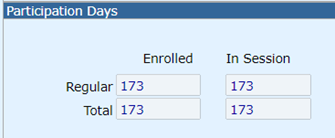
FTE: (Full Time Equivalency) FTE can be found directly on the student approval record and on the claim. FTE represents the time in a school day that a student spends in a program. If a program cost represents a full school day, a student that only attends ½ day would have an FTE of 0.5. FTE is entered manually by I-Star users. FTE will decrease claim costs. Be very cautious when using an FTE of less than 1.0.
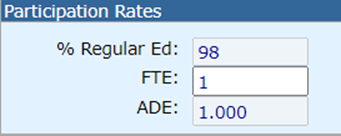

AFR: (Annual Financial Report) A report submitted to ISBE annually for the purpose of auditing school districts and joint agreements. AFRs are submitted by district-hired auditors and are due to the Regional Office of Education on October 14th.
RCDT: (Region-County-District-Type) A number assigned by ISBE for public school district of residence.

IDEA: (Individuals with Disabilities Education Act) The collection and reporting of the special education students ages 3-22.
LEA: (Local Education Agency)
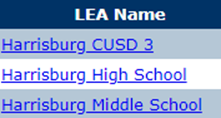
ISTAR: (IEP Student Tracking and Reporting) Web-based system used by ISBE that allows districts/special education cooperatives to input, manage, and approve data for students with disabilities.
IDEA “YES” Special Education Indicator in SIS:
If a student’s Program Indicator for IDEA Services is marked “No”, the student is not eligible nor receiving SPED services.
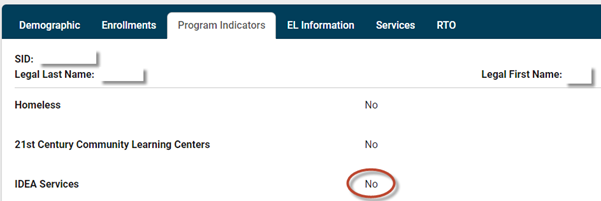
If a student’s Program Indicator for IDEA Services is marked “Yes”, the student is eligible for SPED services, but may or may not be receiving services.

Unreported Tab: This tab shows students who have been marked with a “Yes” for IDEA Services in SIS, but do not have an approval record in I-Star. This tab helps with identifying students who may be eligible for services but were not reported.
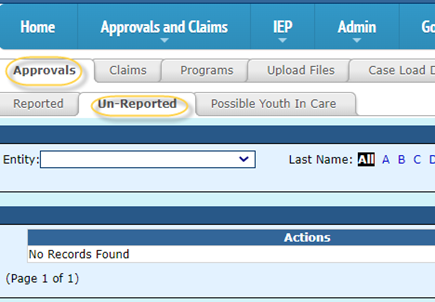
PDA (Percent of Day Attended) in SIS: This can be found on the student enrollment screen as pictured below. Acceptable values are .01 to 1.00. These fields do not have to match and they are not error-checked.

Recheck Edits: Function in I-Star that performs all relevant error-checks on all selected approval or claim records. This updates the I-Star error reports.

Allocation Ratio: The amount of time that a staff member spends with this cost center. To calculate the allocation ratio, divide the number of students served by this employee in this program by the total number of students served by the employee in the entire year. Ex) If the staff member spends all of his/her time with students in this program, the allocation ratio is a 1.0.
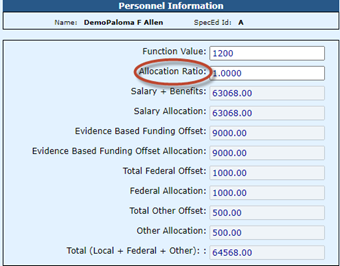
EBF: (Evidence Based Funding) The static dollar amount that districts get back for personnel. EBF was based on $9000 for full time teachers and $3500 for paraprofessionals. These totals were taken from the 2015-2016 school year reimbursement.
SPP 11/13: (State Performance Plans) Indicators 11 & 13 are required indicators that are collected in I-Star.
Indicator 11 eligibility data is required for all students that have approvals in I-Star.
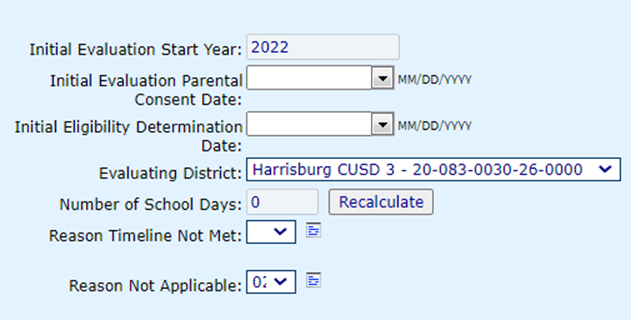
Indicator 13 transition data is required on a student’s IEP upon turning 14 ½ years of age.
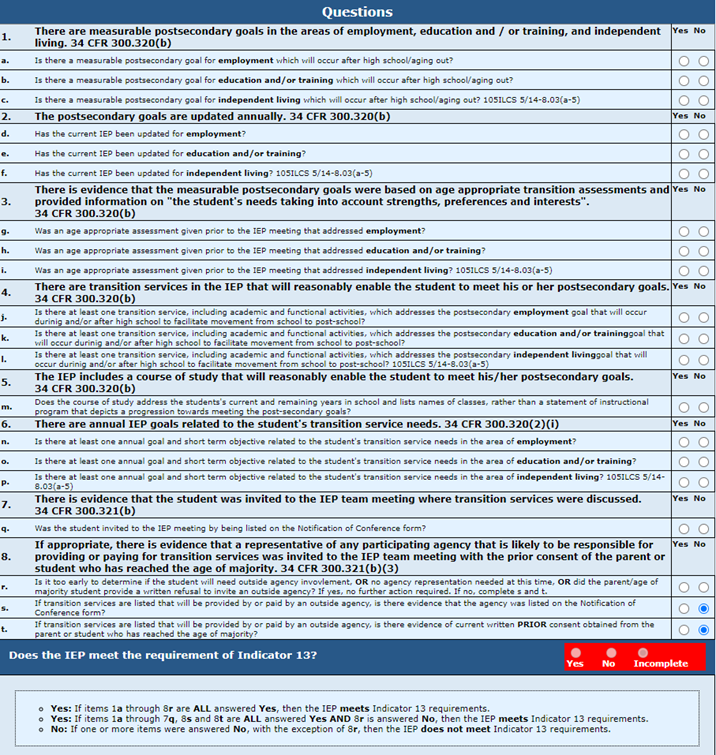
HHI: (Home Hospital Instruction) Work Assignment that is used for teachers who provide home/hospital instruction to students with disabilities only. This is also the only work assignment for personnel that can be reported with a FTE greater than the standard 1.0
34-34: The Emergency Placement Form is completed and submitted to ISBE by school districts seeking reimbursement for costs of emergency and student specific placements in residential facilities that have not been approved by ISBE when no ISBE-approved facility accepted the student or no immediate placement in an ISBE-approved facility was available. This form and all required documents must be complete and submitted prior to the placement for reimbursement to be considered.
34-37: Application for approval for private residential placement/ room & board form is completed and submitted by school districts seeking reimbursement when determined at a student IEP meeting that the least restrictive environment for a student is a private residential placement. This form is to be completed and submitted in a timely manner to allow approval prior to the district requesting the placement.
P50-66B: (Personnel Report) Documentation that shows expenditures and receipts for personnel who directly provide special education instruction to Fund X or tuition students who are included in a program


S50-66B: (Student Report) Documentation that consists of claimable students (Fund E or X) and other SPED students who are also in the same program to produce the Total ADE for the program.
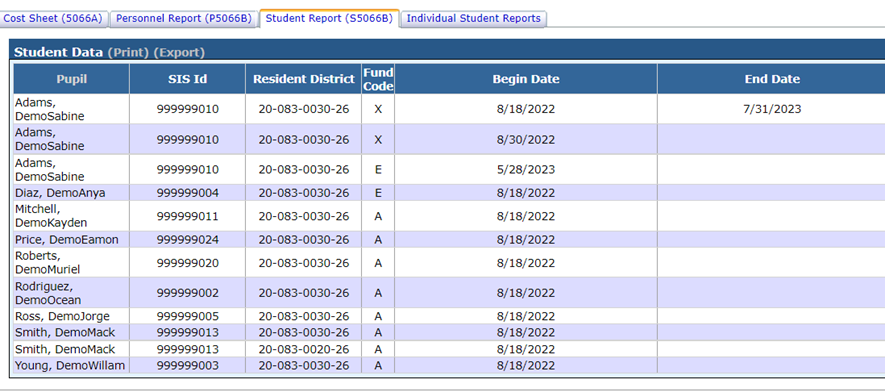

50-66A: (Tuition Cost Sheet) Documentation that allows districts to enter expenditures from the AFR in order to calculate 1.0 ADE cost for Fund Code E, X, and/or tuition billing for a program.
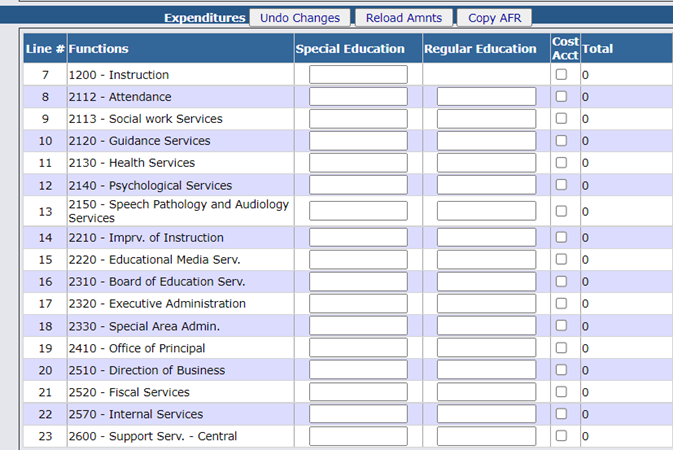
50-66C: (Individual Student Reports) Claim computation report that reflects a student’s cost in a program.
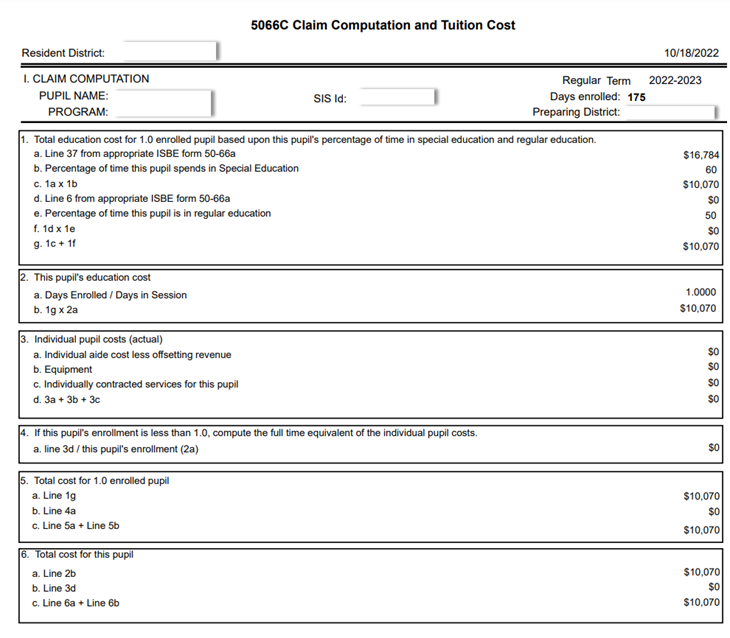
50-66D: (Depreciation Schedule) If equipment is purchased specifically for a special education program that is $5,000 or more, it shall be depreciated on a give-year schedule beginning in the year of purchase.
Cost Per 1.0 ADE: Costs for the entire year for one program if ADE and FTE = 1.0.
Cost Per Pupil: The actual pupil cost based on ADE and FTE in the program.
Per Cap: The amount a local school district charges as tuition to a non-resident student as defined by Section 5/18-3 of the School Code. This amount represents expenditures from local taxes, common school fund monies and federal impact aid. The PCTC is calculated by deducting revenues for various state sources (excluding general state aid), student and community service revenues, and federal revenues (excluding federal impact aid) from the total Operating Expense adding depreciation and dividing by the 9-month ADA for the year.
Per Diem: Daily rate; associated with the daily cost for private facility tuition charges.
Caseload: An optional tool in I-Star that is designed to print class list reports to give to service providers, track student minutes, track case managers and build programs.
Program: (Cost Center) A combination of special education instructional services, supportive service supplies, materials, physical plant adjustments and other special educational facilities designated by a local education agency as meeting the common educational needs of a group of students with disabilities. A program is used to determine the cost per pupil for special education tuition to claim for students that are Fund Code E and/or to create tuition bills.
End/Add: I-Star tool used to create a copy of an approved record when changes to an IEP or ISP occur.
Student Profile: A portion of I-Star that collects and displays unique records for a child such as address, Medicaid Number and events such as annual review/reevaluation meetings.
LEA List Maintenance: I-Star administrative task used to customize Serving District and Serving School drop-down options on approval records.
LEA Determinations: A process that ISBE uses to select LEAs for tiered monitoring and support by identifying potential risk. Indicators are used to measure success and determine the degree to which LEAs are implementing the requirements of Part B in IDEA.
Resident District: The school district in which the student resides.
Resident School: The school that represents the school in the district where the student either attends for educational instruction or where the student would attend if educated at a school in his/her resident district.
Serving District: The Local Education Agency that operates the program. The serving district may be a special education cooperative, a regional office alternative learning program, a state agency or other state-funded school.
Serving School: The school that represents the school or location where the student receives his/her educational instruction. This is where the student is physically seated.
SIS VS I-Star Matching:
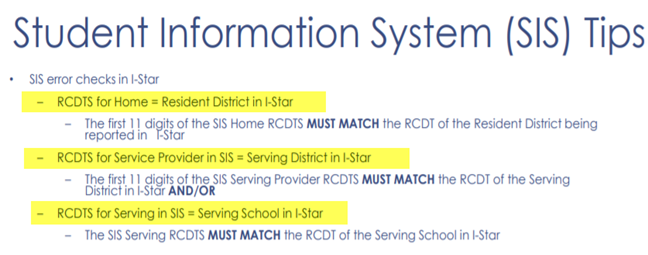
RCDTS for Home in SIS = Resident District in I-Star
RCDTS for Service Provider in SIS = Serving District in I-Star
RCDTS for Serving in SIS = Serving School in I-Star
Enrollment/Exit Dates in SIS must encompass Begin/End Dates in I-Star
Students placed at a Private Facility (Fund B or F) I-Star will be matching the private facility RCDTS to the RCDTS for Serving in SIS.
Personnel-Related Classification Codes:
A: Special Education Teacher
B: Related-Service Provider
C: Para-Professional
D: Administrative
Dec 1 Child Count: An unduplicated count of student approval records that are active and error-free on December 1st 2022 (excluding approvals for Fund Codes N & U).